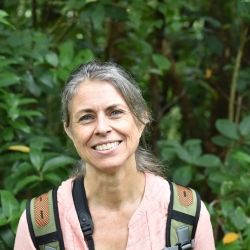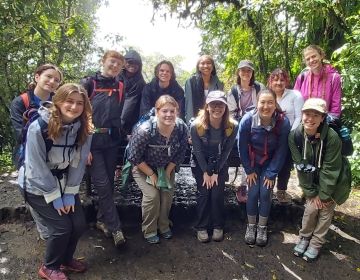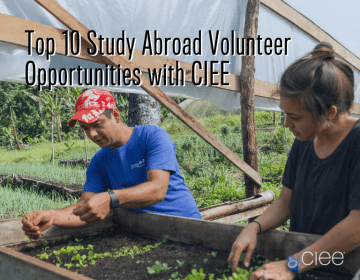CIEE Internship in Landscaping and Cultural Heritage Gardens
Students on the CIEE Program in Sustainability and the Environment get a unique opportunity to make their mark on Monteverde. Interns tackle a "sustainability challenge" for a Monteverde organization and leave behind a product that helps to advance the cause of making the community a little more sustainable. Here are Caroline's, Jordan's, and Alex's stories about what they undertook in a landscaping/gardening internship, supervised by Orlando Calvo.
Caroline Sdregas (University of Colorado-Boulder)
Caroline describes her internship: “My internship here in Monteverde, Costa Rica has been a challenging, yet incredibly rich learning experience for the past four weeks! I have been working with two other students from my program and our internship supervisor, Orlando Calvo (also known as Fish). Our initial mission was to create a heritage garden at the CIEE Study Center here in Monteverde. A heritage garden is a garden area that exemplifies culturally relevant plants and crops from the local area. A heritage garden doesn’t necessarily contain native plants to the area, but more so plants that are important to the culture and life within the area. We did a lot of research prior to any manual work, which included research via the Internet as well as visiting local farms to talk to Monteverde farmers about what they plant and why.
All three of us all took on smaller individual projects to contribute to the garden area in addition to the collective heritage garden. My individual projects include the final master plan drawing, creating and incorporating recycled art into the space, and planting different herbs. Alex’s additional projects include constructing a grass couch and an archway entrance. Jordan’s projects include the design of a successful windbreak for the garden area and to build a small greenhouse. We determined the best space for the garden, and cleared out the area (since there was much debris and sadly, garbage). We then constructed Jordan’s windbreak design all together. After the windbreak fence was finished, we each worked on our individual projects, helping each other along the way. Finally, we worked to create an organized plan for where the 19 heritage plants will be within the garden space, and planted what we could plant during this time of the year.”
Jordan Bertagnolli (Portland State University)
In Jordan’s words: “In an opening in the vegetation, under the hot tropical sun at the CIEE Study Center, an idea is becoming reality. Three study-abroad students, including myself, are working to build a heritage garden based on a document created by students interested in preserving the agricultural heritage of the Monteverde area. Our challenges are varied and our time is limited, but that hasn’t held back our progress.
The area holds potential for many applications, including the heritage garden but also much more. Collectively, we have built a fifteen-meter windbreak, two raised eras (dirt rows for growing inside of the windbreak), a miniature greenhouse, a grass couch and a bamboo entrance. The project highlights the traditional farming methods and plants of the local area as well as some modern flare in terms of landscaping and reused materials for the entrance and greenhouse. The project is coming to an end this weekend as the finishing touches go in. I cherish this opportunity to pass on a little piece of history to future students.”
Alex Crooker (Cornell University)

What Crooker has to say: “The Internship began with surveying the space, both in terms of soil quality and measurements of the space, to develop a site analysis. With this, we came up with proposals and sketches of our ideas. During this part I learned many technical aspects of drawing a site analysis and what is important to consider. Once finished, we collaborated and came up with a final design that merged all of our concepts together. Upon brainstorming we realized that the largest object to tackle was the creation of a windbreak/wall around the heritage garden. During this part of the project I took away a lot: I learned how to use a machete and how to work with bamboo, I dug holes for posts without cement, and learned how to use a material called ‘saran’. We spent multiple days brainstorming and then building the wall, which really was a large project.
Once the wall was finished we were able to move on to our individual projects that we had chosen to complete. My two projects were building a grass couch and a bamboo entryway. The grass couch consisted of a lot of landscaping and forming the earth to a desirable shape then layering sections of grass on top. I learned how to shape earth well, and how to reuse logs, to save on materials for making the grass couch. The entryway consists of reusing old bamboo and scraps from creating the windbreak. Posts were sunk into the ground, and a frame for the tops was constructed. A lattice across top was created using old telephone wire and bamboo. Overall I learned a lot, got dirty, and am proud of what has been accomplished.”
And the Master of Ceremonies, Orlando Calvo, being a garden guru:
Related Posts
Costa Rica vs. Argentina: Which is Better for Study Abroad?
Imagine yourself sipping mate in a bustling Buenos Aires café or lounging peacefully in a hammock overlooking Costa Rica's lush rainforests. These contrasting scenes represent just a glimpse of the... keep reading
Happy Earth Day: Today and Every Day
Happy Earth Day! Every April 22, this global event comes around to remind us how precious our planet is, what sustainable efforts we can make to protect Earth, and that... keep reading
Top 10 Study Abroad Volunteer Opportunities with CIEE
Have you ever wondered if you could volunteer abroad? Perhaps you're looking into study abroad programs that provide international volunteer opportunities. If you’re itching to study abroad and truly make... keep reading



